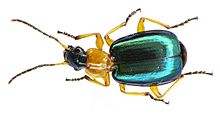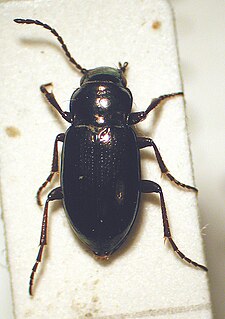
The Trachypachidae are a family of beetles that generally resemble small ground beetles, but that are distinguished by the large coxae of their rearmost legs. There are only six known extant species in the family, with four species of Trachypachus found in northern Eurasia and northern North America, and two species of Systolosoma in Chile. They were much more diverse in the past, with many members belonging to the extinct subfamily Eodromeinae, the first fossils known of this family are of the genera Petrodromeus and Permunda from the Permian-Triassic boundary of Russia.

Calathus is a genus of ground beetle native to the Palearctic, the Near East and North Africa. There are at least 190 described species in Calathus.

Calosoma is a genus of large ground beetles that occur primarily throughout the Northern Hemisphere, and are referred to as caterpillar hunters or searchers. Many of the 167 species are largely or entirely black, but some have bright metallic coloration. They produce a foul-smelling spray from glands near the tip of the abdomen. They are recognizable due to their large thorax, which is almost the size of their abdomen and much wider than their head.
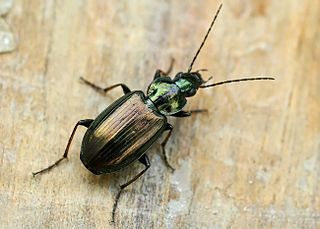
Agonum sexpunctatum is a wet-loving, peatland species of ground beetle native to the Palearctic and the Near East.

Chlaenius is a large and diverse genus of ground beetle. It is native to the Palearctic, the Near East, North Africa, Afrotropical region, and the Nearctic. Worldwide, roughly 1,000 species are currently recognized with the majority of known species occurring in the Oriental and Afrotropical regions. The genus is divided into many subgenera.

Carabus scabrosus, common name Huge Violet Ground Beetle, is a species of beetles belonging to the Carabidae family.
Nebria nigerrima is a species of ground beetle in the Nebriinae subfamily that can be found in Asian countries such as Armenia, Iran, and Turkey. In Europe, it can only be found in the southern part of Russia. In 2004 it was described in Georgia.
Brachinus alexandri is a species of ground beetle from the Brachininae subfamily that can be found in Ukraine, southern part of Russia, Near East, Albania, Armenia, Azerbaijan, Asia Minor, Turkey, Bulgaria, Greece, The species are 9 millimetres (0.35 in) in length, and have black eyes and body, with orange head and legs.
Brachinus pectoralis is a species of ground beetle in the Brachininae subfamily that can be found in Albania, Bulgaria, Corsica, Canary Islands, France, Greece, Hungary, Italy, Slovakia, Ukraine, southern part of Russia, European part of Turkey, and Spain. Besides European countries it can be found in Central Asian ones such as Armenia, Georgia, Kazakhstan, Kyrgyzstan, Tajikistan and Uzbekistan.
Brachinus psophia is a species of ground beetle from the Brachininae subfamily that can be found in Bulgaria,Greece, Italy, Albania, Austria, Czech Republic, France, Hungary, Moldova, Slovakia, Ukraine, all states of former Yugoslavia, and in Western Europe. It can also be found on such European islands as Corsica, Sardinia and Sicily, and on the island of Cyprus in Asia. Besides European countries it can be found in Armenia, Iran, Iraq and Central Asian republics. It is also known from Turkey, The species were also found and described in Georgia in 2004, and Romania.
Harpalus hospes is a species of ground beetle native to Europe, where it can be found in such countries as Austria, Bulgaria, Czech Republic, Greece, Hungary, Moldova, Romania, Slovakia, Slovenia, Ukraine and southern part of Russia. It is also found in such Asian countries as Armenia, Georgia, Iran, Turkey and Uzbekistan.
Harpalus saxicola is a species of ground beetle native to Palaearctic and Near East. In Europe, it can be found in such countries as Albania, Austria, Bulgaria, Greece, Hungary, Moldova, Romania, Slovakia, Slovenia, Sweden, Ukraine, all states of former Yugoslavia, and southern part of Russia. It is also found in Armenia, Cyprus, Georgia, Iran, Israel, Syria and Turkey.
Harpalus salinus is a species of ground beetle native to Europe, where it can be found in Ukraine and southern part of Russia. It is also found in such Asian countries as Afghanistan, Kazakhstan, Kyrgyzstan, Tajikistan, Indian province Kashmir, and Chinese ones such as Xinjiang, Xizang and Tibet.
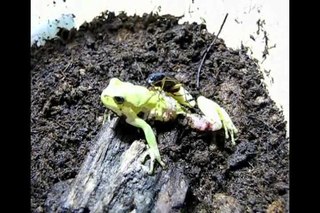
Epomis circumscriptus is a species of ground beetle native to the Palearctic, the Near East, and North Africa.
Calathus distinguendus is a species of ground beetle from the Platyninae subfamily that can be found in Bulgaria, Greece, Kosovo, Moldova, Montenegro, North Macedonia, Serbia, Voivodina, southern part of Russia and European part of Turkey. It is also found in Georgia, Asia Minor, Caucasus, and Crimea. It have 1 millimetre (0.039 in) long genitalia.

Acupalpus flavicollis is a species of ground beetle in the family Carabidae.

Epomis dejeani is a species of ground beetle native to the Palearctic and the Middle East. It is known from Bosnia and Herzegovina, Greece, Hungary, Israel, Italy, Russia, Syria, Turkey, and Ukraine.
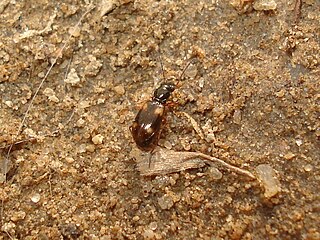
Bembidion quadrimaculatum is a species of ground beetle of the family Carabidae. It is found in Europe & Northern Asia, North America, and Southern Asia.
Carl Hildebrand Lindroth was a Swedish entomologist and a professor at Lund University. He was a specialist in carabidology, with a special interest in biogeography. He was a strong proponent of the glacial refugium hypothesis and made use of the framework to explain the distribution patterns of Scandinavian beetles.
